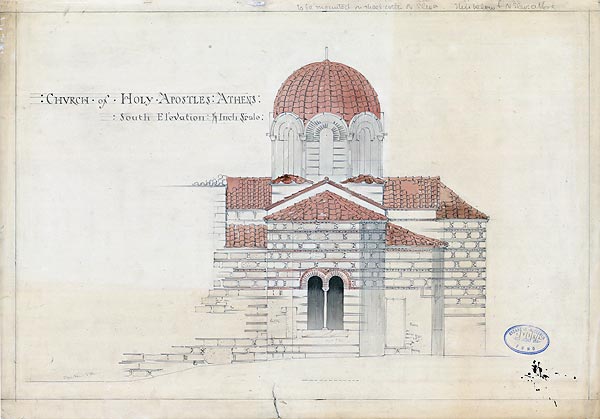About the BRF Collection

The Byzantine Research Fund Archive (BRF) is a unique collection of architectural drawings, photographs and notebooks created from the late 19th century to the middle of the 20th century by a small team of British architects trained in the Arts & Crafts tradition whose studies of Byzantium shaped the Byzantine Revival in later years.
The collection contains over 1,500 drawings and 1,000 photographs, numerous notebooks and the corporate records associated with the Byzantine Research and Publication Fund, the original body created in 1907 to support this work. Although the Fund was associated with the BSA from the time it was founded, it was not until 1937 that the BSA formerly took over the property and operation of it. The BRF Archive contains records of Byzantine monuments in Greece, Turkey, Italy, the Near East, Egypt, and Cyprus. In some cases, the collection contains the only record of a monument before its destruction in modern times, the most important example being the church of Hagios Demetrios in Thessalonike which was almost completely destroyed in the Great Fire of 1917 shortly after being recorded by one of the BRF architects, Walter Sykes George. It also contains personal records of the following architects; Robert Weir Schultz, Sidney Howard Barnsley, Walter Sykes George, William Harvey, Harold Swainson, Peter Gus Corbett, and A.H.S (Peter) Megaw. The aspirations of the BRF Archive Project today are to make these materials accessible to a wide range of researchers.
Furniture (old reading desk) and Metalwork (candelsticks) in the church. The photograph is annotated in pencil at the back. Further annotation in pencil survives. See also photos nos. 02/14/03/01 (BRFno.02/03/01/084) and 02/14/03/02 (BRFno 02/03/01/085).
Carved wooden narthex doors to basilica. The photograph is annotated and dated in ink at the back: 'CARVED WOODEN DOORS FROM NARTHEX TO BASILICA BETHLEHEM. 1909'. Further annotation in pencil survives. See also photo no. 02/14/04/01 (BRFno 02/03/01/088).
Carved wooden narthex doors to basilica. The photograph is annotated and dated in ink at the back: 'CARVED WOODEN DOORS FROM NARTHEX TO NAVE OF BASILICA OF THE NATIVITY BETHLEHEM. 1909'. Further annotation in pencil survives. See also photo no. 02/14/03/04 (BRFno 02/03/01/087).
Main entrance door. The photograph is annotated in ink at the back: 'MAIN ENTRANCE DOOR BETHLEHEM (fragment of cornice peeping from Armenian wall indicate pos. of small door). Further annotation in ink and pencil survives.
View of the mosaic decoration- East wall, North trancept, (Christological scene- The Incredibility of Thomas) .
Column with carved capital and fresco decoration.
Part of mosaic decoration in the aisles (the Councils?). Duplicate print exists. Oversize prints.
Part of mosaic decoration in the aisles, south wall of nave (the Councils?). Duplicate print exists. Oversize prints.
Part of mosaic decoration in the aisles (the Councils?). Duplicate print exists. Oversize prints.
Part of mosaic decoration in the aisles with a narrative scene. Duplicate print exists with annotation on back 'not published' etc. Oversize prints.
East apse of Greek choir of the basilica. The photograph is dated and annotated in ink at the back: 'EAST PASE OF GREEK CHOIR OF BASILICA + GREEK CONVENT. 1908'.
North apse and medieval countrefort. The photograph is dated and annotated in ink at the back: 'NORTH APSE + MEDIEVAL COUNTRE FORT (OF OLD LATIN CHURCH PROBABLY) 1908'.
South apse of the basilica from the Greek tower. The photograph is dated and annotated in ink at the back: 'S. APSE BASILICA BETHLEHEM FROM GREEK TOWER 1908'.
Wooden-carved model of the church in the British Museum.
Wooden-carved model of the church in the British Museum.
Part of mosaic decoration in the aisles (the Councils?). Duplicate print exists. Oversize prints.
View of the city with the Dome of the Rock. The photograph is annotated in pencil at the back.
Interior of the kiosk at the Rock. The photograph is annotated in pencil at the back.
Interior of the kiosk at the Rock. The photograph is annotated in pencil at the back.
Façade of a mosque (Al Aqsa Mosque?) at the Rock. The photograph is annotated in pencil at the back.
Distant view of the Holy Sepulchre(?). The photograph is annotated in pencil at the back.
Upper church: The Meeting of S. Francis and S. Clara. This is a commercial photograph. It is annotated in pencil at the back. Creator unknown.
Bardi chapel: St Francis before the Sultan. This is a commercial photograph. It is annotated in pencil at the back. Creator unknown.
Death of S. Francis by Giotto. This is a commercial photograph. It is annotated in pencil at the back. Creator unknown.
West façade. This is a commercial photograph. It is annotated in pencil at the back. It is stamped: 'Sept. 1888'. Creator unknown.
Spanish chapel: Allegory of sciences. This is a commercial photograph. It is annotated in pencil at the back. Creator unknown.
Upper church: The Adoration of S. Francis. This is a commercial photograph. It is annotated in pencil at the back. Creator unknown.
Upper church: The vow of chasisty. This is a commercial photograph. It is annotated in pencil at the back. Creator unknown.
Upper church: St Francis receiving the stigmata (?). This is a commercial photograph. It is annotated in pencil at the back. Creator unknown.
Empress Theodora and her Ladies (sanctuary apse, north side wall). This is a commercial photograph. It is annotated in pencil at the back. Creator unknown.
The sermon on the mount. This is a commercial photograph. It is annotated in pencil at the back. It is stamped: 'Sept. 1888'. Creator unknown.


